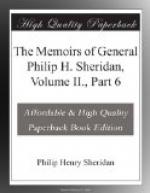During the march to the new camp the weather was not so cold as that experienced in coming down from Camp Supply; still, rains were frequent, and each was invariably followed by a depression of temperature and high winds, very destructive to our animals, much weakened by lack of food. The men fared pretty well, however, for on the rough march along the Washita, and during our stay at Fort Cobb, they had learned to protect themselves materially from the cold. For this they had contrived many devices, the favorite means being dugouts—that is, pits dug in the ground, and roofed over, with shelter-tents, and having at one end a fire-place and chimney ingeniously constructed with sod. In these they lived very snugly —four men in each—and would often amuse themselves by poking their heads out and barking at the occupants of adjacent huts in imitation of the prairie-dog, whose comfortable nests had probably suggested the idea of dugouts. The men were much better off, in fact, than many of the officers, for the high winds frequently made havoc with our wall-tents. The horses and mules suffered most of all. They could not be sheltered, and having neither grain nor grass, the poor beasts were in no condition to stand the chilling blasts. Still, by cutting down cottonwood-trees, and letting the animals browse on the small soft branches, we managed to keep them up till, finally even this wretched food beginning to grow scarce, I had all except a few of the strongest sent to Fort Arbuckle, near which place we had been able, fortunately, to purchase some fields of corn from the half-civilized Chickasaws and Choctaws.
Through mismanagement, as previously noted, the greater part of the supplies which I had ordered hauled to Arbuckle the preceding fall had not got farther on the way than Fort Gibson, which post was about four hundred miles off, and the road abominable, particularly east of Arbuckle, where it ran through a low region called “boggy bottom.” All along this route were abandoned wagons, left sticking in the mud, and hence the transportation was growing so short that I began to fear trouble in getting subsistence up for the men. Still, it would not do to withdraw, so I made a trip to Arbuckle chiefly for the purpose of reorganizing the transportation, but also with a view to opening a new route to that post, the road to lie on high ground, so as to avoid the creeks and mud that had been giving us so much trouble. If such a road could be made, I hoped to get up enough rations and grain from the cornfields purchased to send out a formidable expedition against the Cheyennes, so I set out for Arbuckle accompanied by my quartermaster, Colonel A. J. McGonigle. “California Joe” also went along to guide us through the scrub-oaks covering the ridge, but even the most thorough exploration failed to discover any route more practicable than that already in use; indeed, the high ground was, if anything, worse than the bottom land, our horses in the springy places and quicksands often miring to their knees. The ground was so soft and wet, in fact, that we had to make most of the way on foot, so by the time we reached Arbuckle I was glad to abandon the new road project.




